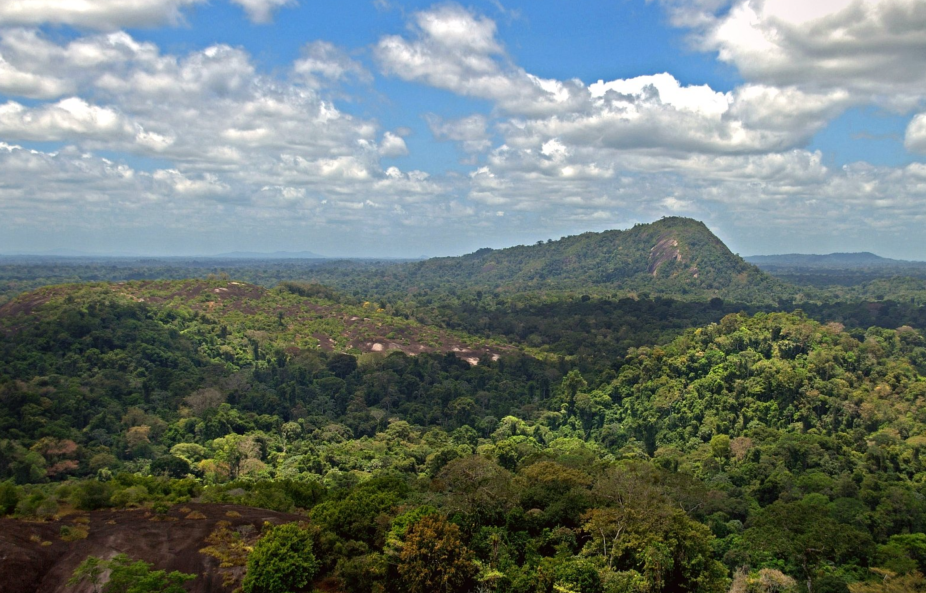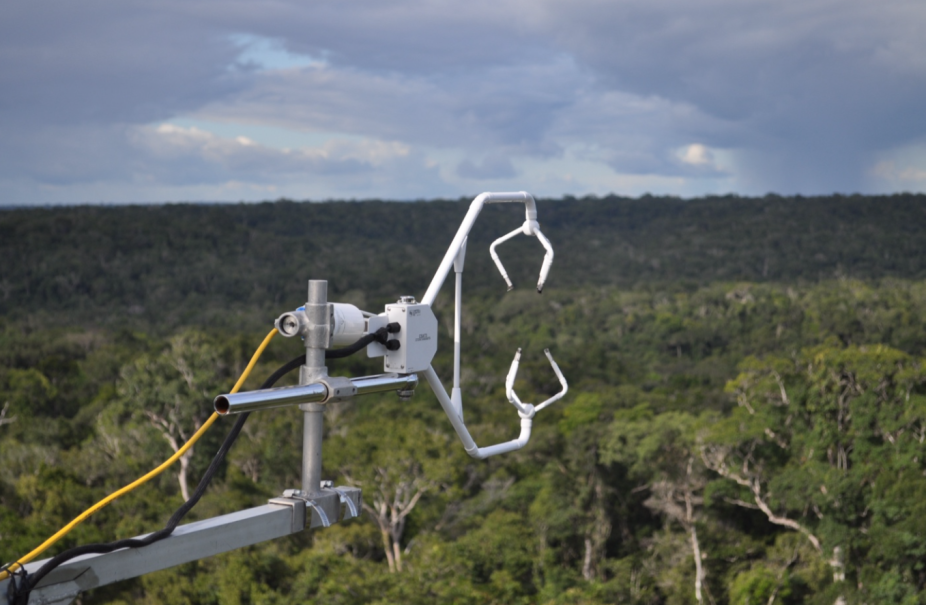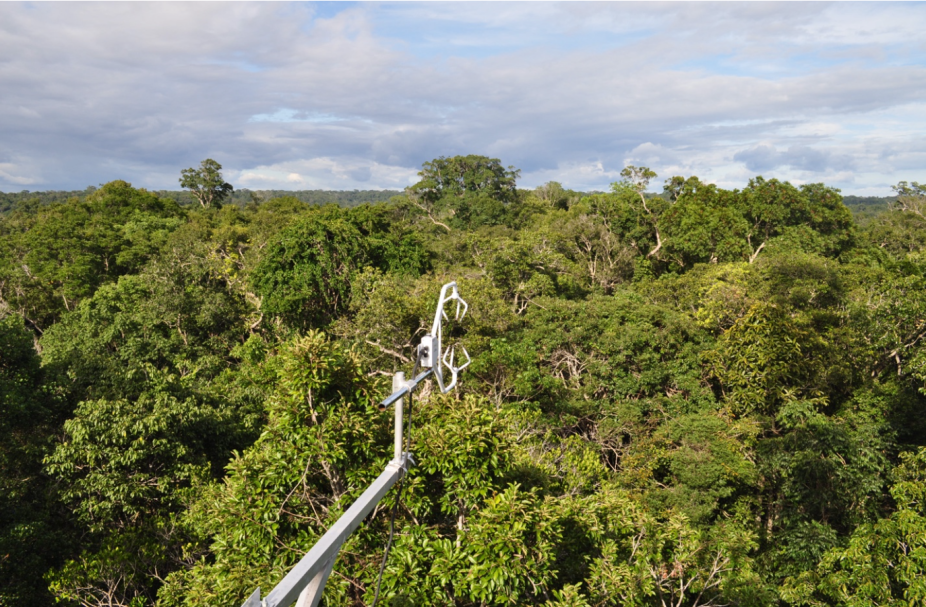Simulated forests, real trees: mapping modeled data onto a living, breathing ecosystem
by Shira Feldman
“You can feel the Amazon. You can almost hear nature communicating.”
—Einara Zahn, lead researcher

Amazon jungle from above. Photo credit: David Evers.
A new study, conducted with the help of CISL supercomputers Cheyenne and Derecho, investigates key aspects of the carbon and water cycle that sustains life on earth. The team of researchers developed and tested innovative methods to distinguish between plant transpiration and soil evaporation using advanced simulations.
As a result of this research, scientists now have more tools to assess how forests react to environmental stressors, such as heatwaves and droughts. NSF NCAR provides access to these powerful computing resources to NSF-funded Earth system science researchers, offering small allocations continually and reviewing large-scale proposals twice per year (see University Allocations for more details).
The new research, entitled “Numerical Investigation of Observational Flux Partitioning Methods for Water Vapor and Carbon Dioxide,” is published in the June 2024 issue of Journal of Geophysical Research: Biogeosciences.

Sensor that measures turbulence above the forest. Taken in the Amazon in 2014, when lead researcher Einara Zahn was pursuing her master’s in Environmental Engineering in Brazil.
The team, based in Princeton University and other institutions, researched the total exchange of carbon dioxide and water vapor between ecosystems and the atmosphere. The team focused on how well different methods can separate this total exchange into contributions from plants versus contributions from the soil—also called “flux partitioning.” Scientists easily measure the total gas exchange using eddy-covariance towers (which track gas exchange via rotating air movements, or "eddies"). However, separating the contributions from plants (photosynthesis and transpiration) versus soil (respiration and evaporation) is challenging.
"The main challenge is to quantify how much the forest alone was responsible for, versus the soil," explained Einara Zahn, lead researcher. "This is vital for understanding water usage in agriculture, ecosystem responses to climate change, and improving climate model accuracy."
“We know how to measure the combined fluxes,” she continued. “We have eddy covariance towers; we can measure that. But quantifying the distinct contributions from the soil and the plants over a long period of time and large footprint is the main challenge.”
“Numerical simulations were the most important part of this research. There are many questions we can answer just by having this tool alone."
The study focused on partitioning total evapotranspiration—the combined water loss from plants and soil—and net CO2 flux, which represents the balance of carbon uptake by plants and release from the soil. In addition to investigating two previously developed methods, the researchers developed three novel approaches, utilizing turbulence data readily available from atmospheric towers, to distinguish between these components.
Zahn explained the pragmatic reason that the team decided to use turbulence as a metric: “[Turbulence is] a little unusual because other models might use information about the plants or other meteorological variables. But we decided to explore turbulence because the eddy covariance tower is measuring turbulence for us across a wide network of towers—that's data we have readily available.”

Sensor that measures turbulence above the forest.
Zahn also discussed the challenges of measuring partitioning using turbulence, especially knowing where to place the sensors: “In the paper, we highlight the measurement height. You want to measure as close as possible to the canopy top, because then you get the relevant turbulent motions. You can measure turbulence bringing water vapor from the plants to the sensor, and then turbulence bringing water vapor from the soil to the sensor, and it's somewhat separated. But if you measure too [high above the canopy top], turbulence is mixing everything so quickly, that by the time it gets to the sensor, it's all blended. So you lose information. The main conclusion is that turbulence can be very useful for this problem. We just need to be careful how we measure our turbulence.”
To address these issues, the team decided to use numerical modeling. “Numerical simulations were the most important aspect of this research,” Zahn observed. “There are many questions we can answer just by having this dataset alone.”
“Using simulations, we can impose all individual fluxes. We can impose how much transpiration the trees are responsible for in the simulation for example. We can also simulate the turbulence. Now, we can implement the partitioning methods and compare how much transpiration the method gets versus how much transpiration we imposed in the simulation.”
“I love numerical simulations. I’m a big fan. I can design a similar forest and add anything I want. It’s amazing that we have a tool that allows us to replicate our environment. If you compare the data to the field experiments, you often will see a great match."
A key aspect of the research involved large eddy simulations, which allowed the team to simulate the complex dynamics of turbulence transporting water vapor and CO2 within and above forest canopies. This enabled them to test and refine their methods, ultimately revealing the strengths and weaknesses of various flux partitioning techniques.
"We don't have a universal method that will always be perfect," Zahn stated. "They all have challenges. But by better understanding how they work and combining the output, we can get more accurate estimates."
The findings of this paper give researchers an idea of the turbulence structure in different canopies and how they may influence the output of their partitioning method. These findings have significant implications for climate modeling, particularly in representing plant transpiration in large-scale simulations. "We can now compare the dataset that we have versus the output of the model for transpiration in that same location, and see how well they compare," Zahn said. "This allows us to improve the way we represent trees in the model and understand how large forests influence climate, cloud formation, and rainfall patterns."
In a follow-up study, the team applied their findings to real-world ecosystems, generating a comprehensive dataset of plant transpiration and below-canopy evaporation across 47 sites in the United States. Now publicly available on Zenodo (an open-access platform for digital research), this five-year dataset offers a valuable resource for hydrometeorology and ecology research.
"People were very receptive to it, because it's five years for 47 sites in the United States: plant transpiration versus below canopy evaporation," Zahn said. "It's a very large dataset that can be used in so many questions, and it's the first of its kind."

The Derecho system at NSF NCAR.
Zahn reminisced a bit about her inspiration for conducting this research. “Way before I started working on this, when I was still in Brazil, I'd been to the Amazon forest. You can feel the Amazon. It's very humid. As you hike into the Amazon, you can hear nature communicating. Birds will be singing over here, and then you will hear others responding from afar. It's just so beautiful. It's hard to describe it. The diversity of plants and animals was inspiring, just marvelous.”
“One day I was there,” Zahn recalled, “and the next, I was trying to understand what is happening in that ecosystem.” Zahn is passionate about the advanced numerical simulations that can teach us so much about the forest’s real ecosystem: “I can design a similar forest and add anything I want. I can add CO2, I can add water vapor. It’s amazing that we have a tool that allows us to replicate our environment. If you compare the data to the field experiments, you often see a great match.”
Zahn speculated on potential future research using this work, discussing how these methods might be applied to other climate elements—such as droughts, heat waves, etc.—to get related datasets. “One very important question is, in our climate models, we need to represent plant transpiration. How can I represent transpiration from the Amazon in a climate model?” she mused. “For instance, you get a dataset of transpiration over a year. So you know how much water plants are releasing over a year. Then you can use that for your own research question.”
“If you're interested in understanding how the forest responded to a heat wave,” she continued, “How much do the plants release, more water or less water? What's the impact on photosynthesis? Are the plants very sensitive or not? Are they shutting down because it's a little hotter, or are they losing even more water? We can combine these types of applications with the parameterization that we use in climate models to represent trees. We know that that's a very uncertain aspect. So we can compare the dataset that we have versus the output of the model for transpiration in that same location, and see how well they compare. Can we improve the parameterization? Can we improve the way we represent the trees in the model by comparing how that parameterization is doing in the climate model versus this dataset that we have now? Those are some ideas.”
The team’s work underscores the power of computational modeling and experimental data in advancing our understanding of complex ecosystem processes. With their datasets and methodologies now available, researchers worldwide can further explore the multilayered relationship between forests and the atmosphere, contributing to more accurate climate predictions and informed environmental management.
Zahn highlighted the importance of teamwork during the research process: “I've been collaborating with a lot of people doing this work, because it’s very challenging,” she said. “This work involved turbulence transport principles, extensive datasets from field experiments, and high-resolution numerical simulations representing plant canopies. I learned a lot from my collaborators.”
She also emphasized the helpful resources provided by CISL computing: "The resources are amazing,” she said. “And the help desk, every time I ran into issues, they were always so helpful."
Elie Bou-Zeid, the principal investigator on the CISL computing allocation and one of the authors of the study, added: “CISL computing resources allowed us to create a detailed digital analog of the forest and the turbulence therein, which was absolutely essential for making this work possible.”
For those interested in further exploring the research, the associated paper, "Observational partitioning of water and CO2 fluxes at National Ecological Observatory Network (NEON) sites: a 5-year dataset of soil and plant components for spatial and temporal analysis," is available in Earth System Science Data.
Zahn E, Ghannam K, Chamecki M, et al. Numerical investigation of observational flux partitioning methods for water vapor and carbon dioxide. Journal of Geophysical Research Biogeosciences. 2024;129(6). https://doi.org/10.1029/2024JG008025
This study was supported by the U.S. National Science Foundation under AGS-2128345 and EAR-2126206.
Have a topic? Contact us. CISL News is seeking recently-published research using CISL resources. Email shiraf@ucar.edu.